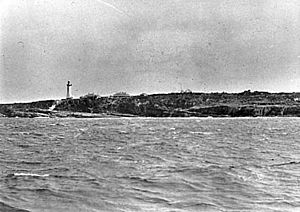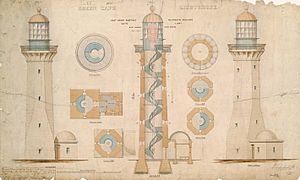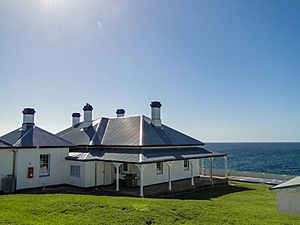Green Cape Lighthouse facts for kids
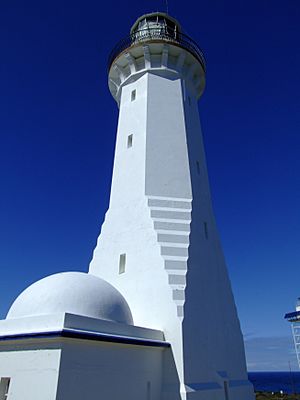 |
|
| Green Cape Lighthouse | |
|
|
|
| Location | Green Cape New South Wales Australia |
|---|---|
| Coordinates | 37°15′41″S 150°02′58″E / 37.26146°S 150.04949°E |
| Year first lit | 1883 |
| Deactivated | 1992 |
| Construction | concrete tower |
| Tower shape | square base octagonal tower with balcony and lantern |
| Markings / pattern | white tower, black balcony |
| Height | 29 metres (95 ft) |
| Focal height | |
| Original lens | 1st order Fresnel lens |
| Intensity | 1,000,000 cd |
| Range | 40 kilometres (25 mi) |
| Characteristic | Fl (2) W 10s. |
| Admiralty number | K2570 |
| NGA number | 6588 |
| ARLHS number | AUS-085 |
The Green Cape Lighthouse is a historic lighthouse found at the very tip of Green Cape. This headland marks the northern edge of Disaster Bay in southern New South Wales, Australia. It is the southernmost lighthouse in New South Wales.
This lighthouse was also the first in Australia to be built using concrete. Standing at 29 metres (95 ft) (about 95 feet) tall, it is the second tallest lighthouse in New South Wales. It helps guide ships safely along the coast.
The famous architect James Barnet designed the lighthouse. It was built between 1881 and 1883 by Albert Wood Aspinall. The Green Cape Lighthouse was added to the New South Wales State Heritage Register in 2013 because of its important history.
Contents
History of Green Cape Lighthouse
Green Cape is traditionally part of the Yuin nation. It is the land of the Thaua people. Their land stretched from Merimbula in the north to Green Cape in the south. It also went west to the Dividing Range.
The first Europeans met the Aboriginal people of this area in 1798. This was when Matthew Flinders visited Twofold Bay, south of Eden. Flinders called Green Cape "the Cape" back then.
Permanent European settlement did not begin until the 1830s and 1840s. This was when farming and whaling started at Twofold Bay. The Imlay brothers were the first settlers. They set up a farming and whaling business.
Twofold Bay became a busy trading center. Another businessman, Ben Boyd, tried to build his own empire in the 1840s. He created "Boyd Town," but it did not last long. Whaling was not a long-term business in the area.
Why a Lighthouse Was Needed
Even though whaling ended, Green Cape was a key point for ships. It stuck out into Disaster Bay, making it a known danger for passing ships. After the New South Wales gold rush in the 1850s, shipping increased. The entire New South Wales coastline became very dangerous.
The first lighthouse in New South Wales was built in 1818. But it took 40 years for the government to start building more lighthouses. By 1872, the whole coastline was being reviewed for safety.
Captain Francis Hixson, who was in charge of marine services, famously said he wanted the New South Wales coast "illuminated like a street with lamps." He succeeded! By the early 1900s, there were 25 lighthouses along the coast. This period was the busiest for lighthouse building in New South Wales.
Building the Lighthouse
The need for a lighthouse at Green Cape was approved in 1873. This happened after many shipwrecks on the southern coast. Ships sailing north would stay close to the shore to avoid strong currents. Green Cape was the first big land point they would meet.
At first, they planned a stone lighthouse. But no one wanted to build it because the local rock was too soft. In 1870, the plans changed to concrete. A budget of £17,000 AUD was set.
James Barnet designed the lighthouse in 1880. A builder named Albert Aspinall won the contract in December 1880. He agreed to build the concrete tower and other buildings for £12,936.
Aspinall faced a big challenge: how to get materials to the remote site. The closest safe spot was Bittangabee Bay. He built a storeroom and jetty there. Then, he spent five months building a 7 kilometres (4.3 mi) (about 4.3 miles) wooden tramway. Horses pulled trolleys with materials along this track.
Building with concrete was a new and bold idea for the time. Green Cape Lighthouse was one of the first and largest concrete structures in Australia. It was also the tallest in New South Wales when it was built. Before 1880, only small houses used concrete. No large public buildings had been built with it.
Work started in 1881. But Aspinall ran into many problems. A thick clay bed needed a lot of digging. Sand kept covering the tramway and building foundations. These difficulties caused delays and increased costs. Aspinall's business eventually failed. His creditors finished the lighthouse.
The Green Cape Lighthouse was ready in 1883. It had a kerosene-powered light that could be seen for 35 km (about 22 miles). The final cost was £19,388.
The Original Light and a Tragic Shipwreck
The lighthouse's original light system is still inside. It uses a special revolving Fresnel lens made by Chance Bros. This light flashed once every 50 seconds and could be seen for 19 nautical miles (35 km; 22 mi) (about 35 km). It was powered by a four-wick kerosene lamp.
On May 30, 1886, the Green Cape Lighthouse was working. That night, the paddle-steamer Ly-ee-Moon crashed into rocks at the base of the lighthouse. It was a clear, calm night. The ship quickly broke apart.
Seventy-one lives were lost in this sinking. It was one of the worst shipwrecks in New South Wales history. Only 15 people survived. Just 24 bodies were found and buried in unmarked graves nearby. Flora MacKillop, the mother of Mary MacKillop, died in this accident.
The Ly-ee-Moon wreck is famous, but the far south coast of New South Wales has seen many shipwrecks. Often, rough seas and bad weather caused these disasters. Disaster Bay has become known as a "graveyard" for ships.
Upgrades and Automation
Over the years, the Green Cape Lighthouse was updated. In 1910, the kerosene lamp was replaced with a new burner. In 1923, the light became even brighter.
In 1911, the Australian government took over responsibility for lighthouses. The Green Cape Lighthouse switched from kerosene to electricity in 1962. Diesel generators provided the power. The old manual winding system was replaced with an electric motor.
In 1967, even better generators were installed. A powerful 1000-watt lamp was added. This made the light very bright, visible for over 20 nautical miles (37 km; 23 mi) (about 37 km). The light now flashed twice every ten seconds. Later, it was connected to the main electricity grid. Over the next 30 years, fewer people were needed to run the lighthouse.
In 1992, a new, modern light was built next to the old tower. This new light uses solar power and is on a tall, metal tower. The historic light was officially turned off on March 17, 1992. The new light is automatic and uses less power.
Since then, the old lighthouse has become a popular place for tourists. In 2009, the Green Cape Lightstation was named an Engineering Heritage National Landmark. It was the first lighthouse in Australia to get this special recognition.
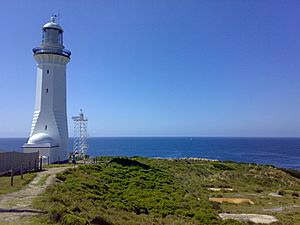 |
|
| Green Cape Light. The current light is the skeletal tower to the right of the original tower. | |
| Location | Green Cape, New South Wales, Australia |
|---|---|
| Coordinates | 37°15′43″S 150°03′00″E / 37.26193°S 150.04987°E |
| Year first constructed | 1992 |
| Construction | metal skeletal tower |
| Tower shape | square pyramidal tower |
| Markings / pattern | white tower |
| Height | 49 feet (15 m) |
| Focal height | |
| Intensity | 37,500 cd |
| Range | 17 nautical miles (31 km; 20 mi) |
| Characteristic | Fl (2) W 15s. |
| Admiralty number | K2570 |
| NGA number | 6588 |
| ARLHS number | AUS-260 |
What is Green Cape Lighthouse Like?
Green Cape is the location of the southernmost lighthouse in New South Wales. It is about 400 km (250 miles) from Sydney. It is also 27 km (17 miles) north of the border with Victoria.
The lightstation is a group of buildings close together. It includes the original lighthouse and the newer 1994 light tower. There are also houses for the Head Keeper and two Assistant Keepers. Other buildings include stables, a telegraph station, and a communication tower.
The original Green Cape Lighthouse stands 29m (95 feet) tall. It is 23m (75 feet) above sea level. The lighthouse tower is octagonal (eight-sided) on a square base. It was built using local rock. A small domed building, once used to store oil, is next to the lighthouse.
The houses for the keepers are simple brick buildings. They are typical of lighthouses around Australia. The Head Keeper's house has four bedrooms, a living room, and a verandah on three sides. The Assistant Keepers' houses are a duplex, meaning two homes joined together. Each has two bedrooms, a living room, and a verandah.
These homes still look much like they did when they were first built. Even though some parts like bathrooms and kitchens have been updated, their original design is clear.
Just outside the lighthouse area, about 300m (984 feet) away, is the Ly-ee-Moon cemetery. The shipwreck itself is offshore. The small cemetery has a simple metal fence. It holds 23 graves, marked by white head and foot stones. A bronze plaque was placed there in 1986.
Further away, about 7 km (4.3 miles) north at Bittangabee Bay, are remains of the original port and jetty. These were built to bring materials for the lighthouse. You can still see a concrete store building and parts of the old jetty. There are also traces of the tramway that carried materials to Green Cape.
The site is well-maintained because it is still a lighthouse and a tourist spot. Staff live there and take care of it every day. Even with modern updates, the original look and layout of the buildings are still very clear.
Visiting Green Cape Lighthouse
The grounds around the lighthouse are open to everyone. You can also take guided tours inside the lighthouse tower on certain days. It is a good idea to book these tours ahead of time.
If you want to stay longer, you can rent the two assistant keepers' cottages. Each cottage can sleep up to six people.
Heritage Importance of Green Cape Lighthouse
The Green Cape Maritime Precinct is very important to the history of New South Wales. It is a key part of the "highway of lights" built along the coast in the late 1800s. Captain Francis Hixson and architect James Barnet helped make this lighthouse a unique project.
Green Cape Lighthouse was one of the first and largest concrete buildings ever attempted in Australia. It was also the tallest in New South Wales at the time. Building it was a huge challenge because of its isolated location. Materials had to be brought by ship to Bittangabee Bay, then transported 7 km (4.3 miles) by horse-drawn tramway through the forest.
The lighthouse is also important because of the Ly-ee-Moon shipwreck. This disaster happened on May 30, 1886. Seventy-one lives were lost, making it one of the worst shipwrecks in the state's history. Fifteen people survived, and 24 bodies were buried in unmarked graves near the lighthouse.
The Green Cape Maritime Precinct was added to the New South Wales State Heritage Register in 2013.
Why Green Cape Lighthouse is Special
- It shows how New South Wales history unfolded: The lighthouse was a big step in making the coast safer for ships. It was a major part of the "highway of lights" system. Its construction was also a big achievement for concrete building in Australia.
- It is linked to important people and events: Captain Francis Hixson wanted the coast "illuminated like a street with lamps." James Barnet, a famous architect, designed many lighthouses, including Green Cape. The site is also linked to the tragic Ly-ee-Moon shipwreck.
- It is a beautiful and unique design: The lighthouse stands out in its isolated, scenic location. Its design, with a square base turning into an octagonal tower, was unusual for its time. Most lighthouses were round.
- It has social meaning: For over 100 years, families lived and worked at the lighthouse. Their lives were shaped by the sea and the land. The cemetery for the Ly-ee-Moon victims also holds social importance. People still remember the disaster each year.
- It can teach us more about history: There are still things to learn about the old tramway and the Aboriginal history of the area. Studies have already found shell middens and artifacts.
- It is rare and special: Its unique design, being one of the first large concrete lighthouses, and its connection to the Ly-ee-Moon shipwreck make it very rare. The large burial ground for shipwreck victims is also uncommon.
- It represents a type of historic place: Green Cape Lighthouse is a great example of the lighthouses built in New South Wales to guide ships. It shows how these stations were managed and how their technology changed over time.
Site Operation
The current light at Green Cape is managed by the Australian Maritime Safety Authority. The entire site is managed by the Department of Environment, Climate Change and Water. It is part of the Ben Boyd National Park.
Images for kids



